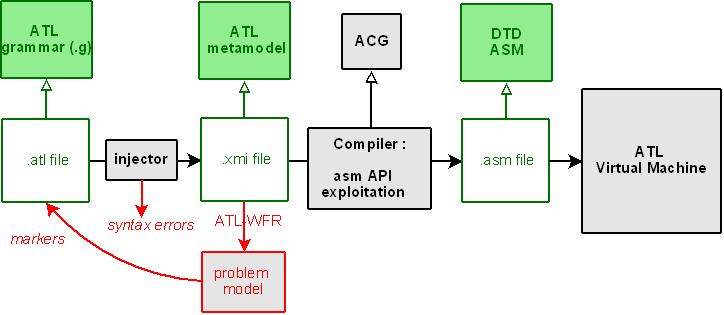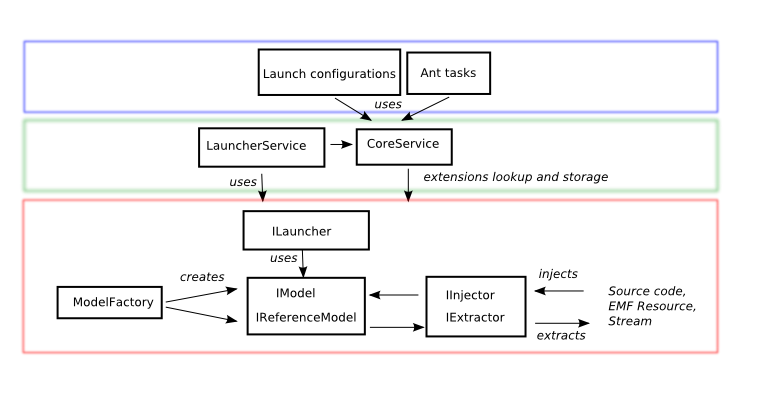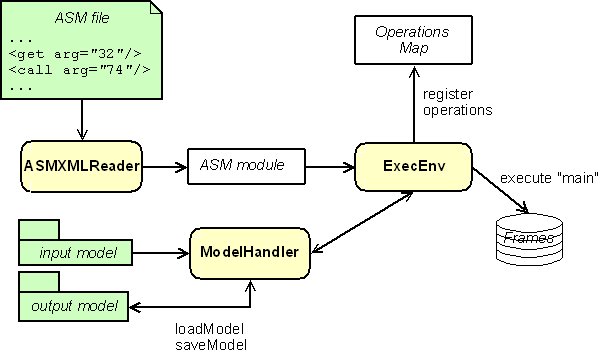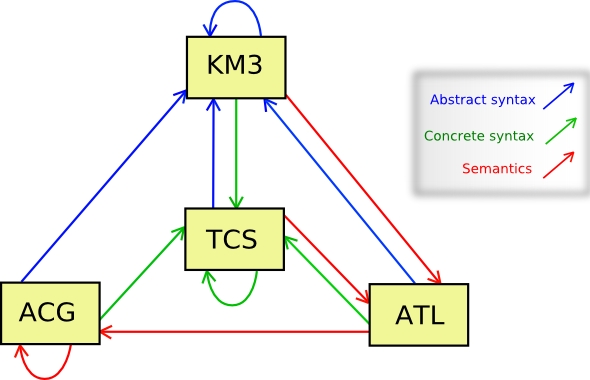Notice: this Wiki will be going read only early in 2024 and edits will no longer be possible. Please see: https://gitlab.eclipse.org/eclipsefdn/helpdesk/-/wikis/Wiki-shutdown-plan for the plan.
ATL/Developer Guide
This documentation aims at contributing to improve the comprehension of the ATL source code.
Contents
ATL Source Code
Plug-ins organization
Below is the list of the ATL plugins:
- ATL Core: provides APIs to launch and extend ATL
- org.eclipse.m2m.atl.common: provide common utilities
- org.eclipse.m2m.atl.core: defines the ATL Core API (launching, model handling)
- org.eclipse.m2m.atl.core.emf: EMF implementation of the Core API
- org.eclipse.m2m.atl.core.ui.vm: defines a wrapper which allow to launch the ATL Regular VM using the Core API
- org.eclipse.m2m.atl.core.ant: provides the ATL ant tasks, based on the Core API
- ADT (ATL Development Tools): Eclipse integration plugins:
- org.eclipse.m2m.atl.core.ui: provides the ATL launch configuration, based on the Core API
- org.eclipse.m2m.atl.adt: provides ATL nature and builder
- org.eclipse.m2m.atl.adt.ui: provides ATL perspective and wizards (new file, new project)
- org.eclipse.m2m.atl.adt.debug: the ATL Regular VM debugger
- org.eclipse.m2m.atl.adt.editor: the ATL textual editor
- ATL Parser and Compiler:
- org.eclipse.m2m.atl.dsls: provides the syntaxic/semantic definition of ATL and ACG
- org.eclipse.m2m.atl.engine: provides ATL compiling and parsing utilities
- ATL Virtual Machines:
- org.eclipse.m2m.atl.engine.emfvm: the ATL EMF-specific VM
- org.eclipse.m2m.atl.engine.vm: the ATL Regular VM, using model handlers:
- org.eclipse.m2m.atl.drivers.emf4atl: the ATL Regular VM model handler for EMF
- org.eclipse.m2m.atl.drivers.uml24atl: the ATL Regular VM model handler for UML2
External dependencies
Historically, ATL imports two libraries : ANTLR version 2 and MDR. Those libraries are not authorized in Eclipse because of their non-compliance with the Eclipse IP policy. Consequently, ATL imposes users to download those libraries by themselves and install them into Eclipse plugin folder.
Today, ATL dependencies have been strongly reduced : ATL only needs ANTLR-runtime (version 3) library, which is compliant with the Eclipse IP policy and included into ATL source code. The MDR library is only necessary for the MDR Model Handler. According to the fact that most of people uses EMF Model Handler (which seems to be more powerful), MDR Model Handler has been separated into a single feature, which is not natively required for ATL.
TCS (Textual Concrete Syntax), a tool for parsing and extraction, is used to generate some ATL components (e.g. ATL-Parser). Unlike ATL, TCS uses both ANTLR library, in version 2 and newly in version 3. TCS is available on GMT. ATL doesn't have any dependency with TCS. Specific injectors depend on ANTLR too.
Install ATL from CVS
Import team project set
ATL provides team project sets in order to simplify access to the source code. You have to download an atl.psf file on your local disk, and then you can import projects in Eclipse using : File->Import->Team->Team Project Set
Anonymous access
Anonymous access use pserver to connect on CVS. Here are the two psf files.
Commiter access
Commiter access use extssh to connect on CVS. Here are the two psf files.
ANTLR installation
Note that the download of this plugin is embedded into atl.psf files. So, if you followed the previous instructions, you don't need to read the next steps. In Eclipse, antlr is managed by the Orbit project. To checkout this plugin, follow those steps :
- Open an anonymous/commiter CVS connection to
dev.eclipse.org, repository/cvsroot/tools - Right-click on the repository location, then choose Refresh branches
- In the wizard, check the
org.eclipse.orbitproject - In the branches, select the one named
v3_0_0 - Checkout
org.antlr.runtime
MDR installation (Regular VM only)
In each psf/ subdirectory there are two .psf files :
- atl.psf
- mdr4atl.psf
The last one provides a project set which only contains the mdr4atl driver, you can use it as for atl.psf.
Now, you need to go to the Plug-in perspective. Some external libraries are required for the plug-in org.eclipse.m2m.atl.drivers.mdr4atl but not available on the CVS repository. You need to download the jar files into the lib/ directory of this project.
Download mdr-standalone.zip from http://mdr.netbeans.org/download/ and put the included jar files into lib/ of plugin org.eclipse.m2m.atl.drivers.mdr4atl.
Note that mdr-standalone.zip is updated more often on the MDR website than in our development source. As a consequence, bugs may appear when using the last-in-date mdr-standalone version of MDR.
When you have finished this operation, there is normally no error left.
WARNING: The MDR model handler is no more maintained, so it may need to be fixed.
Testing
ATL is ready to be tested. There are two ways to use it:
- In the "Plug-in Development perspective", you can launch a Run-time workbench (Click on Run -> Run as -> Run-time workbench).
- You can install ATL in your copy of Eclipse. Go in the Plug-in perspective and select all the plug-in projects. In the context menu choose Export -> Deployable Plug-ins and Fragments.
In the screen Export Plug-ins and Fragments, check if all the projects are selected and choose the output folder.
Now you need to close Eclipse. Enter the "eclipse" directory (which contains plug-ins and features directories) then copy the created Jar files into the "plugins" directory. After that you can restart Eclipse.
ATL Architecture
The ATL architecture consists on:
- a Core, which describes ATL concepts in an abstract way
- a Parser and a Compiler
- Virtual Machines, allowing to execute transformations
- an IDE: editor, debugger, perspective, all based on previous components
The following schema describes ATL components and their role during the execution of a transformation.
ATL VM is intercalated between the ATL compiler and the used frameworks (EMF, MDR), allowing modularity. Consequently, changes on ATL Language only involve ATL compiler.
Core
This schema describes the ATL Core and how it interacts with tools like LaunchConfigurations, Ant tasks.
- An IModel is an adapted representation of a model, suitable for ATL transformations. It provides methods to lookup elements, create new ones, etc...
- The IReferenceModel interface extends the IModel one, and is a specific version of an IModel which symbolizes metamodels. It defines metamodel-specific operations which are useful for ATL transformations
- The ModelFactory is dedicated for model and reference model creation
- The IInjector, IExtractor interfaces provide a way to load and save models previously created by the modelFactory
- The ILauncher interface is dedicated to be implemented by ATL virtual machines: it defines methods to parametrize and launch a transformation
Services
To simplify the use of ATL Core and reduce code duplication, two services are provided: CoreService and LauncherService.
CoreService
This utility class provide a way to lookup into eclipse extensions, or an internal storage, for Core implementations. Those implementations can be registered into the CoreService for a standalone use. For instance, here we register the extensions needed to launch a transformation using EMF-specific VM, in standalone:
CoreService.registerLauncher(new EMFVMLauncher());
CoreService.registerFactory("EMF", EMFModelFactory.class);
CoreService.registerExtractor("EMF", new EMFExtractor());
CoreService.registerInjector("EMF", new EMFInjector());
LauncherService
The launcher service allow to launch a transformation from a set of parameters like maps of path and maps of model names: this is strongly related to launch configurations and ant tasks as it allows to launch the transformation on any virtual machine.
EMF interactions
The main implementation of the ATL Core is the EMF one, which is used by ATL itself for parsing and compilation. It is defined under the org.eclipse.m2m.atl.core.emf plugin.
Here is an explanation about the use ATL EMF-specific injector/extractor. For both, we use the EMF notation to select Resources:
| Resource Type | ATL EMF API Syntax | Example |
|---|---|---|
| File system Resource | file:/<path> | file:/D:/eclipse/workspace/mmproject/sample_metamodel.ecore |
| EMF uri | <uri> | http://www.eclipse.org/uml2/2.1.0/UML |
| pathmap | pathmap:<path> | pathmap://PROFILE/sample_profile.uml#_0 |
| Workspace Resource | platform:/resource/<path> | platform:/resource/mmproject/sample_metamodel.ecore |
| Plug-in Resource | platform:/plugin/<path> | platform:/plugin/mmproject/sample_metamodel.ecore |
Here is an example of usage:
ModelFactory factory = CoreService.createModelFactory("EMF");
IReferenceModel umlMetamodel = factory.newReferenceModel();
injector.inject(umlMetamodel, "http://www.eclipse.org/uml2/2.1.0/UML");
According to the previous table, you can use another notation to load the model:
injector.inject(sampleMetamodel, "file:/D:/eclipse/workspace/mmproject/sample_metamodel.ecore");
Examples of use
- The ATL launch configuration delegate and the ATL non-regression test are examples of launching using the Launcher Service.
- The public2private example (UI part) shows how to directly use the Core
ATL Virtual Machine
The ATL VM is a byte code interpreter which manages OCL and ATL types hierarchy. A complete ATL VM specification is available : ATL_VMSpecification. This specification consists on a precise description of the ATL VM functionalities, but doesn't describe the implementation. The intent is to allow any developer to create an ATL VM in any language. The Native Library (org.eclipse.m2m.atl.engine.vm.nativelib package) gathers all basic type definitions used by the ATL VM : OCL types and ATL specific types. Both are defined at the same level, and use reflexion. OCL appears at several levels in the ATL architecture :
- nativelib implementation
- OCL package in the ATL, ACG and TCS metamodels
The following schema shows the ATL VM working:
During ATL VM initialization, every operations are registered into a Map. The ExecEnv Class contains the virtual execution environment. It deals with the operation map which registers all operations used by the transformation. It contains every information used by a given execution, like models, and is recreated for each execution. Operations are executed sequentially, into frames, according to their type. For instance, in ATL, a call of the append() method is directly mapped to a call to the corresponding method in the ASMSequence class.
The Frame stores and throws all error messages. The ASMStackFrame is dedicated to ASM methods, when the StackFrame is dedicated to native methods. Execution errors come from ATL VM when the method Frame.printstacktrace is called.
At this time there are two implementations of the ATL VM.
Regular VM
The Regular VM is the first version of the ATL Virtual Machine. The implementation is abstracted from the used model management framework, using model handlers. Model Handlers consists on an abstraction layer dedicated to model access. This access is implemented by two classes : ASMModel et ASMModelElement.
ATL contains three plugins drivers corresponding to different Model Handlers : EMF, MDR, UML2. Each plugin implements those abstract classes :
- AtlModelHandler : implementation of the basic tasks "newModel", "saveModel", "loadModel"
- ASMModel : getElementsByType implementation, framework oriented "newModelElement" method, etc...
- ASMModelElement : "allInstances" implementation, etc...
Input and output models are loaded using the same API and are differenciated with an "isTarget" property. That API implements the "getMetaElementsByName" method which correspond to the "findme" ASM instruction.
This VM implementation is still used in ATL, because it is strongly linked to several parts (now only the ATL Debugger). But the Regular VM has a lot of performance issues, especially because of the model handler architecture.
EMF-specific VM
The EMF-specific VM is a redefinition of the Regular one, which resolves a lot of performance issues by avoiding EObjects wrapping. Its API allow to consider EMF Resources directly as models, without complex loading as done previously in the Regular VM.
ASM format
ASM language is a kind of assembly language, adapted to model handling. The low level of ASM allows modularity facilities, with the intent to provide easier model management possibilities. The current file format for ASM is XML. Thus it allows not to care about any syntax and to only focus on bytecode. An ASM file only contains names and string constants. No Ecore reference is present. Those are resolved by launch configurations and AMMA Megamodel, with a name binding.
Serialization
ASM transformations are serialized in a way to increase performance and preempt further serializations like binary files. The ASMXMLWriter class is an ASM extractor used to save ASM into a file. Serialization computes the constant pool, which factorizes constants, values and method calls by generating an ordered constants list at the top of the ASM file. ASMWriter is the parent abstract class which allows a binary implementation of ASM injection and extraction.
Instructions
All instructions are explained into ATL VM specification. Here are details about some of them:
- The getasm instruction retrieves the ATL Context Module, i.e. The "thisModule" equivalent for ATL.
- N symbolizes a native type, ATL specific
- TransientLink are traceability links
- all functions like "getLinkBySourceElement" are implemented in the nativelib
- Object creation :
- The "new" instruction takes two parameters : the metamodel name and the classifier type. Then it creates an element of this type in the output model (only one is allowed). The parameters are not available in the bytecode because they are pushed on the stack before calling instruction.
- We can notice that ATL allows only one output model, but the ATL VM could be extended two allow many others.
- A delete instruction could be implemented in the ATL VM
- ATL provides the newInstance method which is directly mapped to the Model Handler method. This method doesn't generates a new because the call is dynamic. The main advantage is that the newInstance is directly applied to the class and do not use the ATL VM stack for that (otherwise it should store the class element).
Parser
ATL parsing is done using a parser defined in TCS, which outputs an ATL model conforming to the ATL metamodel. Then, an ATL-WFR transformation (interpreted by the engine) generates a problem model. This model produces errors interpreted by the editor and translated into markers, visible on the ATL file on each compilation.
To manually parse (or extract) ATL files, see the ATLParser class.
Note that as ATL parser implements IInjector and IExtractor interfaces, it can be use in ant tasks to parse or extract atl files (just specify "ATL" as injector/extractor name).
Compiler
Two versions of the ATL compiler are available : 2004 and 2006. The 2006 version of ATL compiler uses ACG. The 2004 version uses ATP, the historical ACG predecessor.
To manually compile ATL files, see the AtlDefaultCompiler class.
ACG (ATL VM Code Generator)
ACG is a compiler-oriented DSL, which intends to make easier to create a compiler targeting the ATL VM. A compiler described with ACG generates ASM files and contains a description of ASM instructions to generate for each type of input elements, coming from a compiled file. Therefore the input of this kind of compiler is a model describing the content of a compiled file (for instance, an ATL file).
An ACG file, when compiled, looks through the input model using a visitor design pattern. ACG is bootstrapped : an ACG.acg file exists and describes the ACG compiler. Since an ACG file describes precisely ASM instructions, the ACG.acg file is rather trivial.
A complete ACG documentation is available here.
The following schema places ACG in the AMMA platform.




